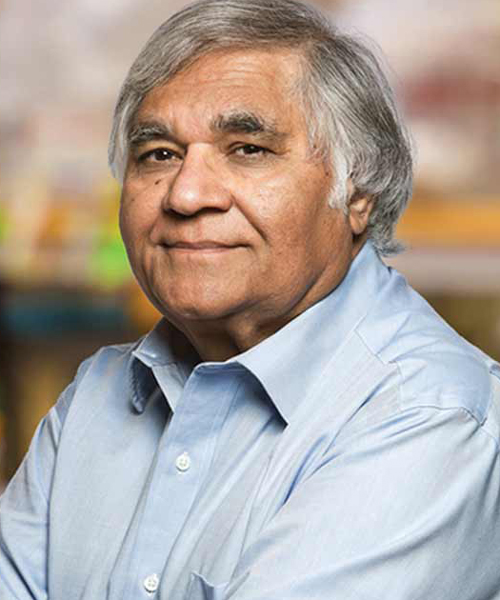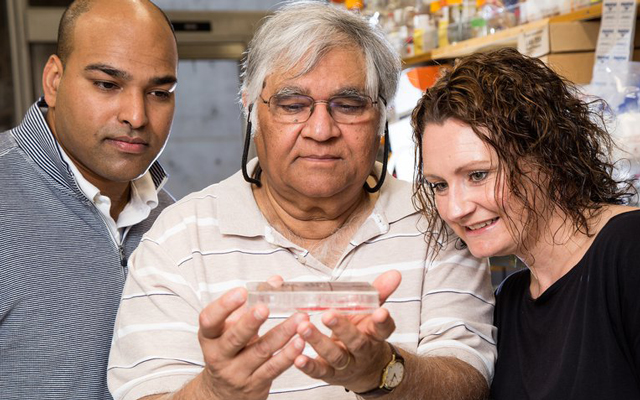More than 20 years ago, legendary US basketball player Magic Johnson was diagnosed with HIV, but he is still alive because AIDS therapies have made significant progress. US Senator Ted Kennedy was not as fortunate, because the tumour he had developed, called glioblastoma multiforme, kills people in as little as 14 months from diagnosis.
But soon new treatments could cut short the virulent life of glioblastomas. Therapies currently in the pipeline could turn this highly malignant tumour into a treatable form of cancer, said Inder M. Verma, an American Cancer Society professor and a 1994 TWAS Fellow, at a recent conference in Trieste, Italy.
Verma was invited by Mauro Giacca, the director of the International Centre for Genetic Engineering and Biotechnology (ICGEB) in Trieste, to describe a number of strategies that he and his team have applied to halt this malignancy. In particular, Verma described how a protein called NF-kB that he has recently studied has a role in easing glioblastoma's quick proliferation, and how it might be an ideal target for anticancer therapies.
Verma has been studying glioblastoma for more than 20 years, and today is a leading international authority. He heads the laboratory of genetics at The Salk Institute in La Jolla, California, where he supervises a group of scientists who are investigating the molecular mechanisms that make glioblastoma a quick-proliferating tumour with a near 100% rate of recurrence.
Verma left India at 18, looking for adventurous life. He moved to Israel not long after the Six-Day War in 1967, and obtained his PhD in biochemistry at The Weizmann Institute of Science in Rehovot in 1971. Soon after, he joined the Massachusetts Institute of Technology as a postdoctoral fellow in biology, in David Baltimore's laboratory. There, he became an expert on reverse transcriptase, and its use in making cDNAs, that is copies of DNA. His scientific achievements have brought him several international awards, including the Medal for Outstanding Scientist of North American Scientists of Indian Origin (1985), the US National Institutes of Health (NIH) Merit Award and the NIH Outstanding Investigator Award, membership to the prestigious National Academy of Sciences (US). He is currently the Editor in Chief of Proceedings National Academy Of Sciences (PNAS).
"In the last 40 years, we have learned some big lessons in tumor biology," he told an audience of about 100 young scientists and researchers at ICGEB. "These lessons have changed our perspectives, increasing the chance to treat many malignancies." Cancer-causing mutations, he explained, affect all the cells in a tumour. But since each cancer grows progressively, changing its molecular features, these mutations can ultimately differ from cell to cell, which explains why many standard therapies fail. In addition, the reason a tumour can grow and spread to distant organs (forming metastases) is that it acquires the ability to escape the immune system's surveillance. This gain of new function applies to most tumours.
According to the New England Journal of Medicine, glioblastoma multiforme accounts for approximately 50% of the 22,500 new cases of brain cancer diagnosed in the United States each year. That's not much if compared to other tumours, but the high mortality rates make this cancer of significant concern. In addition, the glioblastoma tumours worsen the patients' quality of life, invading the brain and impairing cognitive abilities in people who are, on average, in their 50s and 60s.
One characteristic that makes these tumours peculiar is that they don't form metastases, Verma explained, and this could be good reason to investigate their molecular behaviour in a confined location such as the brain. Verma and his team tried to recapitulate the early events that mark the transformation of a cell from normal into a malignant one, giving rise to a glioblastoma.
The scientists used three different combinations of mutations involved in the tumour onset: an oncogene called ras (an oncogene is a gene able to induce cancer); a sentinel gene called p53, well-known as tumor suppressor; and a gene called NF-1, loss of which caused cell proliferation.
However, another key discovery about glioblastoma was that terminally differentiated cells like glia or neurons upon oncogenic assault de-differentiate into stem cells: They re-convert to a primitive stage much like cells in their "infancy". Stem cells continue to replicate and can undergo trans-differentiation, acquiring features that turn them into a brand new type of cells, like blood cells.
This is what causes the onset of the tumour, and this is also the reason why surgery has little effect. "When you get rid of tumour cells you get rid of 99.99% of the tumour," said Verma. "But even a single stem cell that has gone unnoticed and left in place can regenerate a new tumour."
Verma and his team then focused on a protein that acts as a transcription factor. Transcription factors are proteins that spot specific sites along the DNA, and bind them. In this way they trigger the conversion of the information hosted inside the DNA into a new molecule, called RNA, which is ready to be turned into proteins. The transcription factor that Verma and colleagues focused on is called nuclear factor kB (or NF-κB): it drives the expression of a large set of genes. NF-κB has been reported to play an important role in tumor cell development, survival, invasion and chemotherapy resistance.
In the case of glioblastoma, Verma found that when NF-κB is too active it triggers cancer proliferation. Using a mouse model that reproduces the human tumour, he proved that shutting- down NF-kB was a good strategy to slow down cancer growth and increase the lifespan of the animals.
down NF-kB was a good strategy to slow down cancer growth and increase the lifespan of the animals.
"We tested several approaches to shut down NF-kB, using genetic manipulation," said Verma. "We shut-off the activity of a protein that is required for activation of NF-kB. This strategy yielded promising results, as they reduced tumour growth and increased the lifespan of lab mice. Unfortunately, what works in lab models may not always apply to humans. To be effective, genetic modifications should hit each cell, but current techniques are not so refined.
That's why Verma and co-workers decided to use a pharmacological approach to manipulate the activity of NF-kB.
"We know that tumours, and glioblastomas in particular, tend to alter their neighbourhood, called microenvironment, to ease the proliferation of tumour cells. Hence, we decided to feed the mice with a small protein (called NBD) that can penetrate glioblastoma cells and block NF-kB under specific circumstances of the microenvironment."
This treatment doubled the survival time of mice, but resulted in high toxicity, especially in the liver. "Taming NF-kB activity is not easy," admitted Verma. "This protein has many roles and switches on at least 100 different genes. That's why more molecular targets and techniques are currently under investigation. However, he added, by exploring these and other possibilities, research is moving closer to human trials.
Will we ever succeed in beating cancer? "Perhaps we won't get rid of cancer, but we'll turn it into a chronic disease, something that's easier to live with," Verma predicted.
Cancers in India are becoming a major problem, and they are different from the rest of the world because of hygiene, lifestyle, nutrition, microbial infections, and other reasons. That, Verma said, is one reason why TWAS and other academies are valuable. "They bring people together, people who otherwise would not be exposed to science and, hence, have a chance to talk to each other and to advance the progress of science," he explained.
"Together we can make great progress. Actually, we have already made great progress."
Cristina Serra

